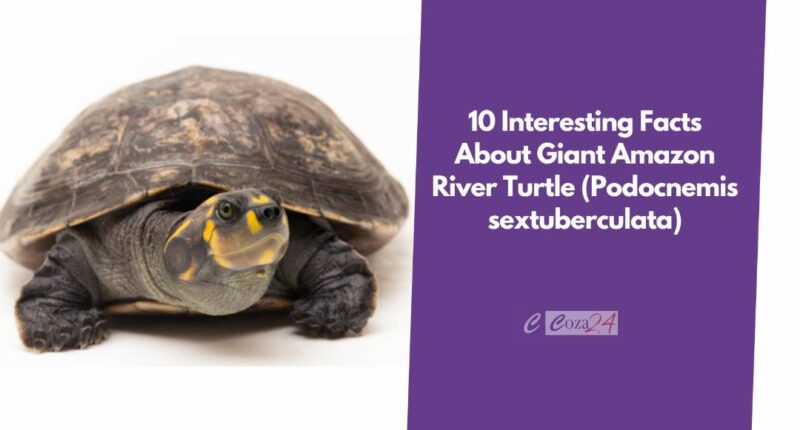The Amazon rainforest is known for its incredible biodiversity, and one of the fascinating creatures that inhabit this lush ecosystem is the Giant Amazon River Turtle, scientifically known as Podocnemis sextuberculata.
These remarkable reptiles have captured the imagination of both scientists and nature enthusiasts alike. In this article, we will explore ten intriguing facts about the Giant Amazon River Turtle, shedding light on their unique characteristics, behavior, and ecological significance.
Table of Contents
- 1 1. The Giant Amazon River Turtle’s Size and Appearance
- 2 2. Habitat and Distribution
- 3 3. Nesting Behavior and Reproduction
- 4 4. Importance of Nesting Sites
- 5 5. Long Lifespan
- 6 6. Conservation Status and Threats
- 7 7. Role in the Ecosystem
- 8 8. Adaptations for Aquatic Life
- 9 9. Cultural Significance
- 10 10. Conservation Efforts
- 11 Frequently Asked Questions
- 11.1 Q: Are Giant Amazon River Turtles endangered?
- 11.2 Q: How long do Giant Amazon River Turtles live?
- 11.3 Q: What do Giant Amazon River Turtles eat?
- 11.4 Q: How many eggs does a Giant Amazon River Turtle lay?
- 11.5 Q: Why are nesting sites important for the conservation of Giant Amazon River Turtles?
- 11.6 Q: What can individuals do to help conserve Giant Amazon River Turtles?
- 12 Conclusion
1. The Giant Amazon River Turtle’s Size and Appearance
The Giant Amazon River Turtle is one of the largest freshwater turtles in the world. Males can reach an impressive length of up to three feet, while females can grow even larger, measuring over four feet. These turtles have a distinct appearance, with a dark brown or black carapace (shell) and a yellowish plastron (underside). Their large heads and powerful jaws enable them to feed on a variety of plants and invertebrates.
2. Habitat and Distribution
These turtles are endemic to the Amazon River basin, which spans across several South American countries, including Brazil, Peru, and Colombia. They primarily inhabit slow-moving rivers, lakes, and flooded forests. The Giant Amazon River Turtle relies on the region’s abundant water bodies for nesting and foraging.
3. Nesting Behavior and Reproduction
One of the most remarkable aspects of the Giant Amazon River Turtle’s life cycle is its nesting behavior. Female turtles travel long distances from the water to find suitable nesting sites, often returning to the same area year after year. They dig large holes in sandy riverbanks or sandy beaches and lay around 50 to 150 eggs in each nest. After covering the eggs, the female returns to the water, leaving the eggs to incubate on their own.
4. Importance of Nesting Sites
The nesting sites of the Giant Amazon River Turtle play a crucial role in the overall health of the species. The sand provides a warm and protective environment for the eggs, ensuring their successful development. These nesting sites are also significant for maintaining genetic diversity within the population. Protecting these areas is essential for the long-term conservation of these turtles.
5. Long Lifespan
Giant Amazon River Turtles are known for their longevity. These remarkable creatures can live for several decades, with some individuals reaching up to a century in age. Their slow growth rate and late sexual maturity contribute to their extended lifespan.
6. Conservation Status and Threats
Despite their resilient nature, Giant Amazon River Turtles face numerous threats that endanger their populations. Habitat loss due to deforestation, illegal egg collection, and hunting for their meat and eggs pose significant challenges to their survival. Conservation efforts and initiatives are crucial to protecting these magnificent turtles and their habitats.
7. Role in the Ecosystem
Giant Amazon River Turtles play a vital role in the Amazon rainforest ecosystem. As herbivores, they help maintain the balance of plant species by feeding on aquatic vegetation. Additionally, their eggs and hatchlings provide a source of food for predators such as caimans, birds, and other reptiles.
8. Adaptations for Aquatic Life
To thrive in their aquatic environment, Giant Amazon River Turtles have developed several adaptations. Their streamlined shells enable efficient movement through water, and their webbed feet facilitate swimming. These adaptations allow them to navigate through the complex river systems of the Amazon rainforest.
9. Cultural Significance
Giant Amazon River Turtles hold cultural significance for indigenous communities living in the Amazon region. They are often considered sacred animals and are integral to traditional beliefs and practices. The conservation of these turtles not only benefits the ecosystem but also helps preserve cultural heritage.
10. Conservation Efforts
Various organizations and researchers are actively working towards the conservation of Giant Amazon River Turtles. These initiatives focus on protecting nesting sites, raising awareness about the species, and implementing sustainable practices to ensure their long-term survival. By supporting these conservation efforts, individuals can contribute to the preservation of this iconic Amazonian species.
Frequently Asked Questions
Q: Are Giant Amazon River Turtles endangered?
A: Yes, Giant Amazon River Turtles are listed as an endangered species due to habitat loss, hunting, and illegal trade.
Q: How long do Giant Amazon River Turtles live?
A: Giant Amazon River Turtles have an impressive lifespan, often exceeding 50 years in the wild, and some individuals have been recorded to live up to 100 years.
Q: What do Giant Amazon River Turtles eat?
A: Giant Amazon River Turtles are herbivorous, primarily feeding on a variety of aquatic plants and fruits. They occasionally consume invertebrates as well.
Q: How many eggs does a Giant Amazon River Turtle lay?
A: Female Giant Amazon River Turtles lay between 50 and 150 eggs in each nest, depending on the individual.
Q: Why are nesting sites important for the conservation of Giant Amazon River Turtles?
A: Nesting sites provide a safe environment for egg incubation and contribute to the genetic diversity of the population. Protecting these sites is vital for the species’ survival.
Q: What can individuals do to help conserve Giant Amazon River Turtles?
A: Individuals can support conservation efforts by promoting sustainable practices, participating in awareness campaigns, and contributing to organizations dedicated to protecting these turtles and their habitats.
Conclusion
The Giant Amazon River Turtle, with its impressive size, unique nesting behavior, and ecological significance, is truly a remarkable species. As guardians of the Amazon rainforest, it is our responsibility to ensure their long-term survival. By understanding their biology, raising awareness, and actively participating in conservation efforts, we can contribute to the preservation of these extraordinary creatures for future generations to admire and cherish.
NEXT POST | Michael Harris Jr. sentenced for killing Bobby Scott











